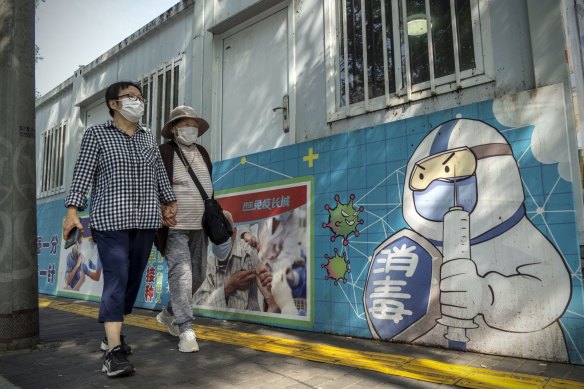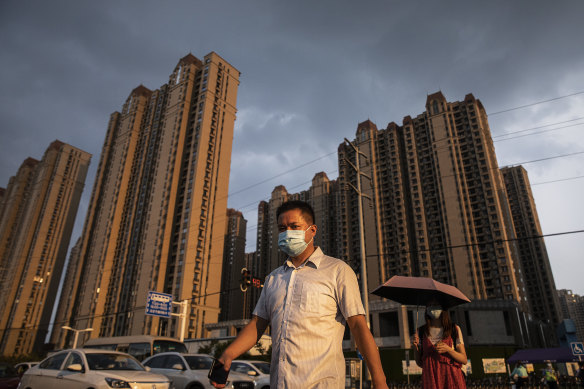The reasons for why China’s growth rate has slumped are well understood.
The major one is Xi’s harsh zero-COVID policy, which has seen near-continuous rolling lockdowns of China’s major cities and industrial hubs. In the second quarter it was a protracted lockdown of Shanghai that was a major factor in the economy’s stagnation.
The property crisis, triggered by Beijing’s imposition of hard limits to property developers’ leverage, has caused an implosion of the developers, a spate of defaults on their debts and a slump in house prices and sales.

China’s economy has been battered by its stringent zero-COVID policies.Credit:Bloomberg
There have been spillover effects into other sectors reliant on the property industry and a widespread revolt by mortgagors who had borrowed to fund purchases of apartments before they were built and now find themselves with debts but no apartments. Local governments that rely on property sales for much of their income are also stressed.
A centrally directed increase in state-owned bank lending – the major Chinese banks have increased lending by more than 20 per cent so far this year – doesn’t appear to have offset the impacts of the COVID policy and the property market’s distress.
Xi’s crackdown on technology companies – fintechs, education and ride-share companies – and a reversal of the previous emphasis on creating wealth to redistributing it under the banner of “common prosperity” – has, with the continuing tightening of US restrictions on access to advanced technologies, wiped out the best part of a $US1 trillion ($1.6 trillion) of entrepreneurial wealth.
The obvious conclusion is that the numbers might have embarrassed Xi had they been released even as the congress was being asked to approve his third term, rubber-stamping an unprecedented extension of his period as party leader.
Unemployment among 16 to 24-year-olds is nudging 20 per cent and has more than doubled during Xi’s current five-year term.
Chinese consumers have become cautious, with retail spending slumping and the slowdown in the rest of the world is threatening its exports.
So far this year China’s sharemarket is now more than 15 per cent and its currency has depreciated against the US dollar by more than 11 per cent, despite efforts by the authorities to moderate its slide. State-owned banks have been selling dollars and buying yuan, presumably in response to a central directive.
Another indicator of how China’s economy is tracking is the iron ore price. Six months ago it was trading close to $US160 a tonne. It was still around $US145 a tonne in June. It is now trading just above $US90 a tonne, signalling a sharp fall in industrial activity and fixed asset investment.

The meltdown in China’s property sector has spilled over to other areas of the economy. Credit:Getty
During a news conference on Monday the deputy director of China’s National Development and Reform Commission, Zhao Chenxin, said the economy had rebounded significantly in the third quarter and that from a global perspective China’s economic performance was “outstanding.”
The context and reference points, however, put that into perspective.
After the dismal 0.4 per cent growth in the second quarter even two per cent growth in GDP would appear significant. The rest of the world is admittedly also struggling – the IMF’s forecast for global GDP is growth of 3.2 per cent this year – but emerging economies (which includes China) are expected to grow at 3.7 per cent. For the first time in living memory China’s economy might grow at a lower rate than the rest of the emerging economies. That’s hardly outstanding.
Confirmation of anaemic growth in the middle of the congress to confirm Xi’s coronation would introduce a sour note to the celebrations. It might also lead to some cynicism about the prospect of Xi delivering on his promise – reiterated on Sunday – to grow China to the point where it would be classified as a “medium-developed” country by 2035.
To achieve that objective China would probably need to double the existing size of its economy, which economists say would require a compound annual GDP and per capita income growth rate of close to five per cent between now and then. Per capita GDP would have to grow from about $US12,500 last year to about $US20,000.
Loading
Under Xi, the shift in emphasis from private sector-led growth to the crackdown on private enterprises and the promotion of the state-owned enterprises that are more firmly under the party’s control – and which aren’t anywhere as productive or as profitable as their private sector counterparts in China – will make that achieving that goal even more difficult, particularly as China’s population is ageing and shrinking for the first time in more than half a century.
Given all the headwinds China’s economy is facing and Xi’s continuing commitment to stringent responses to COVID outbreaks it perhaps isn’t surprising that anything less than positive news about the state of the economy would be delayed until the congress has concluded and his continuing leadership confirmed.
The Business Briefing newsletter delivers major stories, exclusive coverage and expert opinion. Sign up to get it every weekday morning.
Stay connected with us on social media platform for instant update click here to join our Twitter, & Facebook
We are now on Telegram. Click here to join our channel (@TechiUpdate) and stay updated with the latest Technology headlines.
For all the latest Business News Click Here
For the latest news and updates, follow us on Google News.
